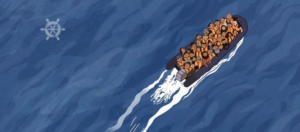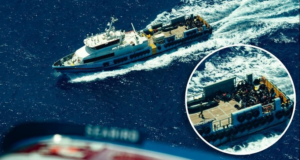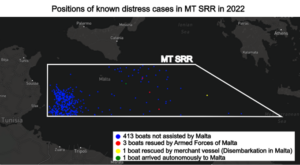Is “SAR 3” a New Operations Area for NGO Ships?

By Alarm Phone
Between 2022 and 2023, a considerable increase in boat departures from eastern Libya has been observed. This route was one of the more frequently used prior to 2017. At that time, many boats were departing from the region of Alexandria, Egypt, allowing people from the Horn of Africa and Sudan to avoid entering Libya. The distance to the Italian coast is nearly 800 nautical miles, with a sailing time of typically 8-10 days.
Departures from this region dramatically decreased in 2018, only to resume four years later in late 2021, possibly reflecting geopolitical developments. Presently, the main departure points for boats crossing from eastern Libya to Italy are the northern urban and periurban areas along the region’s northern coasts, namely Benghazi, Darna and Tobruk. The shortest distance from eastern Libya to Italy is the 365 nautical miles from Benghazi to Capo Passero, the south-eastern corner of Sicily.
The boats departing from eastern Libya are however not the only vessels sailing in the region. Various types of vessels departing from Lebanon and Turkey and heading towards the Ionian Italian coasts might also traverse this area. This is a consequence of the aggressive measures implemented by government actors along the borders with Greece and Cyprus to prevent arrivals or forcibly return those who manage to reach their national waters and land.
Different types of vessels have then been observed on this route. In general, boats departing from Benghazi are typically small fibreglass boats with a single deck and no cabin, equipped with one or two outboard engines, and carrying around 20 to 40 people on board. Boats departing from Darna and Tobruk often appear as larger ex-fishing boats made from mixed materials, with inboard engines, and carrying several hundred people. Boats from Turkey typically include sailing yachts with around one hundred passengers, although mid-sized power boats are also occasionally used. Motor pleasure crafts and decommissioned ferries seem to be the most common boat types reported from Lebanon.
The route from eastern Libya crosses the eastern halves of both the Libyan and Maltese Search and Rescue Regions (SRRs) before reaching the Italian SRR in the Ionian Sea. The Italian and Maltese SRRs overlap from the 36° parallel up until 30 nautical miles further north. Starting from this point, the Maritime Rescue Coordination Center (MRCC) in Rome has been coordinating the SAR operations. South of the 36° parallel, there is a lack of information and, most likely, SAR coordination. This becomes even more critical within the eastern half of the Libyan SRR, where the Joint Rescue Coordination Center (JRCC) in Tripoli is effectively inactive in the area, possibly due to operational limitations (with a distance of around 250 nautical miles between Misrata and Benghazi) as well as the geopolitical situation in the region.


Maps showing last known positions for documented distress cases respectively departing (above) Benghazi, (below) Tobruk from 1.1.2022 – 1.4.2023. Pins coloured yellow for cases rescued by the Civil Fleet. Positions placed by CMRCC documentation and SARchive to the best of its knowledge, from a combination of available actor accounts and media analysis. Cases may be absent where information was unavailable.
Certain groups however, sometimes referred to as the “Libyan Coast Security” or “Libyan Special Naval Forces” but also a group named “Dafadie Albasharia”, appear to be active in this area. Nonetheless, their role remains unclear and is not officially recognized by the international community (essentially the IMO).
On May 4th, Marshal Haftar, the “strongman” in the eastern Libyan region, held a meeting with the Italian Prime Minister and some of her ministers. Although no official communication followed the meeting, the official Italian government bulletin, providing a summary of the two-hour conversation, reported that the primary topic discussed was the unprecedented increase in immigration to Italy. It is speculated upon that the heightened volume of departures from eastern Libya may have been allowed by Marshal Haftar himself, in order to establish a position for engaging with European authorities, particularly Italy.
For the time being, the Italian MRCC is alerting merchant vessels sailing in the area about boats in distress via Inmarsat and possibly other means. In their communications, the officers in Rome specify that they are publishing the SAR case “on behalf of the Libyan Coast Guard.” However, the coordination for most of these SAR cases relayed by IT MRCC and rescued by merchant vessels has ultimately been undertaken by the centre in Rome, resulting in disembarkations in Italy. As on May 10th, where in only one day around 350 people from several SAR events in the Ionian region were disembarked in Italy by four different merchant vessels. In fact, in a region where neither governmental nor non-governmental actors provide SAR operations, merchant vessels play an even more significant role.
However, the crews of commercial ships are not trained for mass casualty events, and a cargo ship is neither equipped nor suitable for such operations. It is worth mentioning that at least two fatal incidents occurred only within the first four months of 2023 while merchant ships were conducting the rescues of small fibreglass boats. The most recent incident took place in the Maltese SRR between April 16th and 17th, and another case occurred in the Libyan SRR on March 11th. The latter incident has been more comprehensively documented by civil actors, as the people on board had previously contacted Alarm Phone and aircraft Seabird could also spot them the day before the cargo ship FROLAND launched a rescue operation. Unfortunately, the small boat capsized during the rescue, and of the 47 people on board, only 17 could be embarked on the cargo ship and eventually disembarked in Pozzallo, Italy, while 30 people are still missing.
In addition, cargo vessels lack preparedness to provide accommodation and support for people rescued at sea, and engaging in an active search and rescue operation until either a port is assigned for disembarking survivors or a rendezvous point is designated for transshipment to governmental assets is time-consuming. This delay often results in significant financial losses for shipowners, which frequently discourages the merchant vessels from responding to distress alerts, despite their legal obligations. In an Alarm Phone SAR case on May 6th of last year, the Sea-Eye 4 played a crucial role. They offered to transship the 34 survivors and take over the operation after the cargo ship BERLIN EXPRESS had deployed a life raft on scene and the BSG BAHAMAS had embarked the survivors. This coordinated effort aimed to minimise the impact on the cargo crew and shipowner, as well as ensure the welfare of those rescued and their disembarkation to Italy.
Indeed, it is important to state that rescues performed by merchant vessels carry a concrete risk of refoulement. Despite the lack of official SAR authority activity in SAR 3, the operations conducted by cargo ships in this area can still result in refoulement to Libya. At least two pushbacks to eastern Libya have recently taken place in the region. The role of the Italian MRCC in these pushbacks is questionable, however.
On April 29th, the crew of aircraft Seabird managed to make contact with the cargo ship GRIMSTAD, which had rescued around 30 people from a small boat. The officer on board reported that the coordination centre in Rome had instructed their vessel to disembark the survivors in Libya. However, the Italian MRCC publicly denied responsibility for the refoulement order (a parliamentary question on the matter is pending). It is possible that the MRCC in Rome did not directly instruct towards refoulement to Libya but rather towards coordinating with Libyan authorities. However, while the authorities in Tripoli invested in by the IMO consistently fail to coordinate such remote operations and leave the technical space for Rome to take over, in the case of the GRIMSTAD it can be surmised that the cargo ship managed to coordinate directly with forces active in the eastern region of the country, as it was the “Libyan Navy” that ultimately transshipped the survivors and brought them back to Libyan shores.
The lack of clear coordination between the coordination centre in Rome and the maritime forces operating in the region, and therefore their role in coordinating refoulements, is exemplified by another SAR case involving 18 people in distress off the shores of Benghazi. The centre in Rome issued a mayday relay for two days, from April 26th to 28th, while unofficial sources reported that an interception had already taken place on the first day of the alert. Many SAR events in this eastern half of the Libyan SRR relayed by Rome have been left unresolved, and it is presumed that many people have been intercepted under local coordination. However, the recent visit of Marshal Haftar to Italy suggests that a stronger cooperation between Rome and Benghazi could soon be established.
Currently, there are no non-governmental rescue vessels operating systematically in this region. The technical and geographical challenges present significant deterrents to implementing a systematic Search and Rescue operation: the vast search surface, potentially covering around 300,000 square kilometres, makes conducting systematic patrols without specific targets impractical. However, there have been instances of targeted rescue operations by non-governmental assets along this route. These rescues occurred when the SAR case and its position were known. In such cases, rescue ships deviated from their usual operational areas either to respond to boats abandoned at sea due to a lack of assistance, which is systematic in the eastern triangular region under Malta’s coordination, or to assist unequipped merchant vessels unable to conduct rescues.

Map showing last known positions for documented distress cases departing Lebanon and Turkey from 1.1.2022 – 1.4.2023. Pins coloured yellow for cases rescued by the Civil Fleet. Positions placed by CMRCC documentation and SARchive to the best of its knowledge, from a combination of available actor accounts and media analysis. Cases may be absent where information was unavailable.
Several noteworthy operations have been carried out by NGOs. For example, in an Alarm Phone SAR case on April 4th of this year, a fishing vessel carrying 600 people was rescued by the Geo Barents, despite challenging weather conditions. Another case involved a pleasure craft that departed from Lebanon and was rescued by the Humanity 1 on September 13th of last year. In this instance, the rescue ship was located 20 hours away from the boat in distress when four people were reported to have jumped overboard in order to reach a cargo vessel which was standing by though unable to conduct a safe transshipment of the 207 people.
Eventually, the rescue ship managed to embark those still on the drifting motor boat and then transfer the individuals recovered from the water by the merchant vessel. After having been at sea for over a week, they were only able to disembark another week later in Taranto, Italy.
Just ten days prior to the intervention of Humanity 1 in this remote area of the Maltese SRR, another boat from Lebanon was left adrift at sea for three days. The distress call, made to Alarm Phone and other actors on September 3rd, could not however get assistance from an NGO ship this time. Instead, it was again a merchant vessel, the BBC PEARL, which ultimately came to the rescue of the 57 people and disembarked them in Crete, Greece, only three days after the alert – too late however for a four-year-old girl who died of dehydration on her way to the hospital.
In light of the evident Search and Rescue gap in this region, the question of whether NGOs should operate more consistently in this area naturally arises. On the one hand, there is a clear need for NGO involvement in order to address the existing SAR gap and support people on the move. However, the technical and geographical challenges in SAR 3, such as the vast surface area and the specific configuration of Libyan territorial waters, introduce new complexities to the operational landscape, which precipitate a reevaluation of non-governmental operational strategies in this region.
Article published in Echoes#6



